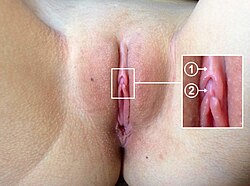
Back Klitoris Afrikaans Klitoris ALS Clitoris AN بظر Arabic Clítoris AST Klitor Azerbaijani Itil BCL Клітар Byelorussian Ласкацень BE-X-OLD Клитор Bulgarian
| Clitoris | |
|---|---|
 Human clitoris. Pubic hair has been deliberately removed to show anatomical detail. Location of (1) clitoral hood and (2) clitoral glans (the clitoral body is beneath the hood). | |
| Details | |
| Precursor | Genital tubercle |
| Part of | Vulva |
| Artery | Dorsal artery of clitoris, deep artery of clitoris, artery of bulb, internal pudendal artery |
| Vein | Superficial dorsal veins of clitoris, deep dorsal vein of clitoris, vein of bulb, internal pudendal veins |
| Nerve | Dorsal nerve of clitoris, pudendal nerve |
| Identifiers | |
| Latin | clitoris |
| Greek | κλειτορίς |
| MeSH | D002987 |
| TA98 | A09.2.02.001 |
| TA2 | 3565 |
| FMA | 9909 |
| Anatomical terminology | |
In amniotes, the clitoris (/ˈklɪtərɪs/ KLIT-ər-iss or /klɪˈtɔːrɪs/ klih-TOR-iss; pl.: clitorises or clitorides) is a female sex organ.[1] In humans, it is the vulva's most erogenous area and generally the primary anatomical source of female sexual pleasure.[2] The clitoris is a complex structure, and its size and sensitivity can vary. The visible portion, the glans, of the clitoris is typically roughly the size and shape of a pea and is estimated to have at least 8,000 nerve endings.[3][4]
Sexological, medical, and psychological debate has focused on the clitoris,[5] and it has been subject to social constructionist analyses and studies.[6] Such discussions range from anatomical accuracy, gender inequality, female genital mutilation, and orgasmic factors and their physiological explanation for the G-spot.[7] The only known purpose of the human clitoris is to provide sexual pleasure.[8]
Knowledge of the clitoris is significantly affected by its cultural perceptions. Studies suggest that knowledge of its existence and anatomy is scant in comparison with that of other sexual organs (especially male sex organs)[9] and that more education about it could help alleviate stigmas, such as the idea that the clitoris and vulva in general are visually unappealing or that female masturbation is taboo and disgraceful.[10][11][12]
The clitoris is homologous to the penis in males.[13]
- ^ Cite error: The named reference
Goodman_Roughgarden_Wingfieldwas invoked but never defined (see the help page). - ^ Cite error: The named reference
Rodgers_O'Connell_Greenberg_Weiten_Carrollwas invoked but never defined (see the help page). - ^ Cite error: The named reference
Carroll_Di Marinowas invoked but never defined (see the help page). - ^
- White, Franny (27 October 2022). "Pleasure-producing human clitoris has more than 10,000 nerve fibers". News. Oregon Health & Science University. Archived from the original on 1 November 2022. Retrieved 2 November 2022.
Blair Peters, M.D., an assistant professor of surgery in the OHSU School of Medicine and a plastic surgeon who specializes in gender-affirming care as part of the OHSU Transgender Health Program, led the research and presented the findings. Peters obtained clitoral nerve tissue from seven adult transmasculine volunteers who underwent gender-affirming genital surgery. Tissues were dyed and magnified 1,000 times under a microscope so individual nerve fibers could be counted with the help of image analysis software.
- Peters, B; Uloko, M; Isabey, P; How many Nerve Fibers Innervate the Human Clitoris? A Histomorphometric Evaluation of the Dorsal Nerve of the Clitoris Archived 2 November 2022 at the Wayback Machine 2 p.m. ET 27 October 2022, 23rd annual joint scientific meeting of Sexual Medicine Society of North America and International Society for Sexual Medicine
- White, Franny (27 October 2022). "Pleasure-producing human clitoris has more than 10,000 nerve fibers". News. Oregon Health & Science University. Archived from the original on 1 November 2022. Retrieved 2 November 2022.
- ^ Cite error: The named reference
Moore_Blechner_Shragewas invoked but never defined (see the help page). - ^ Cite error: The named reference
Moore_Wade_Labuskiwas invoked but never defined (see the help page). - ^ Cite error: The named reference
Shrage_Schwartz_Wood_Blechnerwas invoked but never defined (see the help page). - ^ Cite error: The named reference
Rodgers_O'Connell_Kilchevskywas invoked but never defined (see the help page). - ^ Cite error: The named reference
Balcombewas invoked but never defined (see the help page). - ^ Cite error: The named reference
Ogletree_Wade_Waskulwas invoked but never defined (see the help page). - ^ Cite error: The named reference
The Wall Street Journalwas invoked but never defined (see the help page). - ^ Cite error: The named reference
Moyewas invoked but never defined (see the help page). - ^ Tortora, Gerard J; Anagnostakos, Nicholas P (1987). Principles of anatomy and physiology (5th ed.). New York: Harper & Row. pp. 727–728. ISBN 978-0060466695.